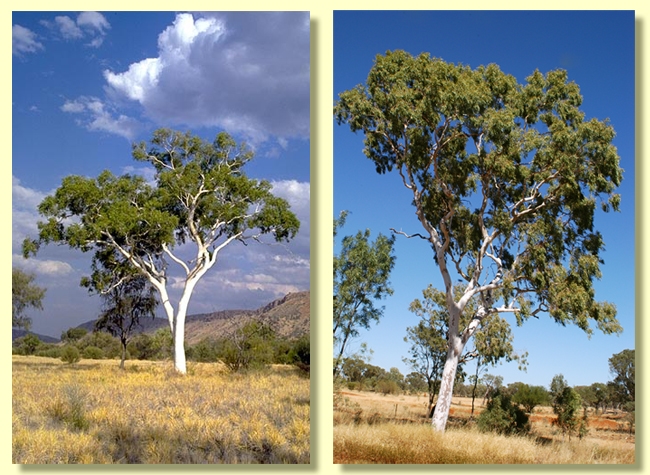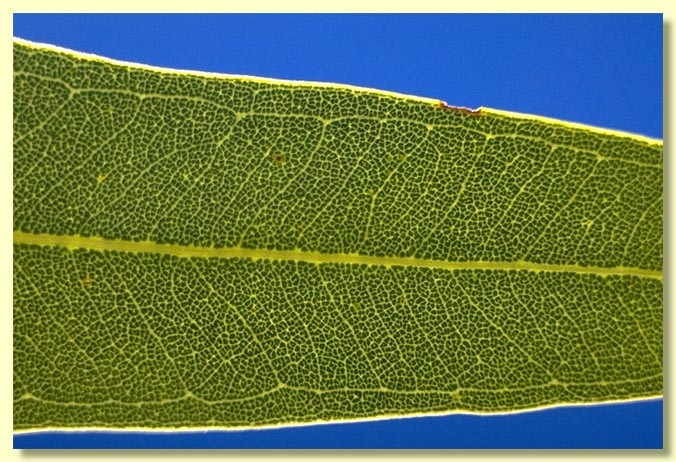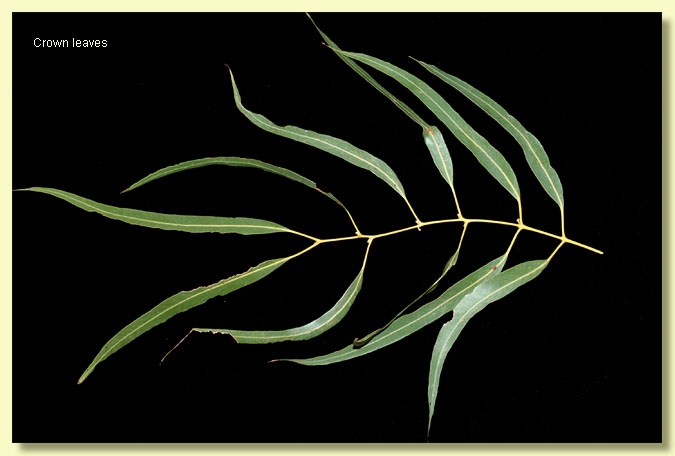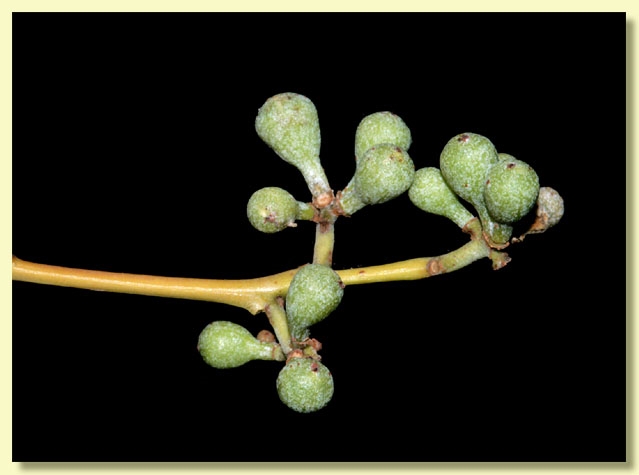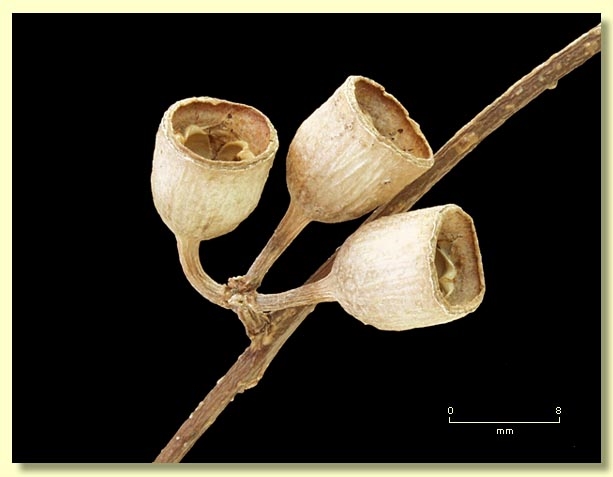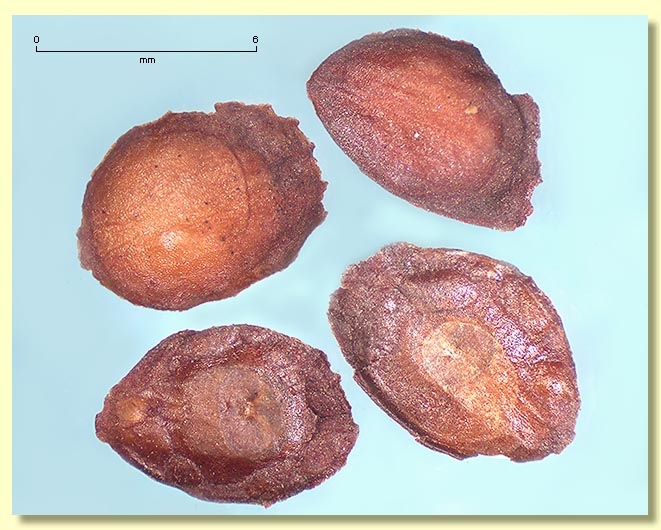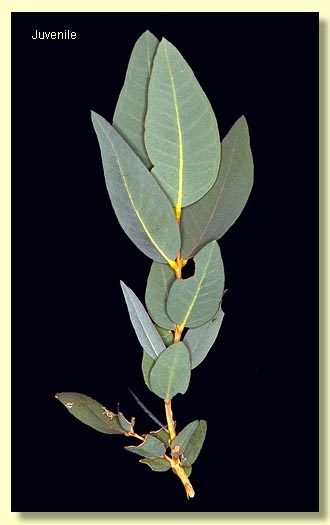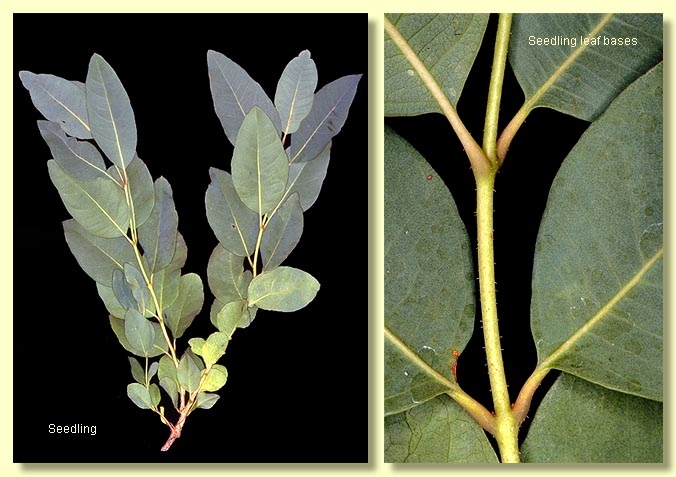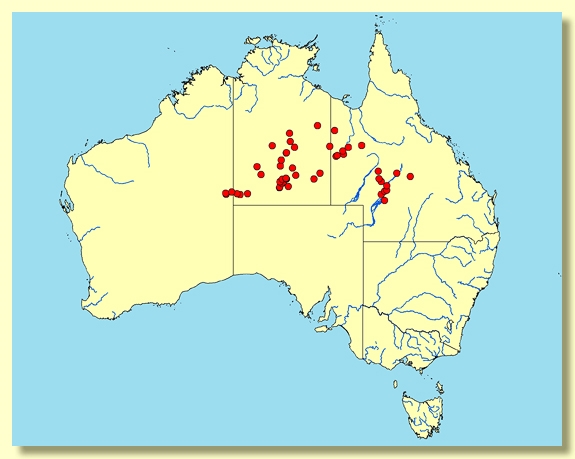Euclid - Online edition
Corymbia aparrerinja
Corymbia | Blakearia
Corymbia aparrerinja K.D.Hill & L.A.S.Johnson, Telopea 6: 453 (1995).
Eucalyptus aparrerinja (K.D.Hill & L.A.S.Johnson) Brooker, Aust. Syst. Bot. 13: 137 (2000). T: Northern Territory: Gosse range, SW Macdonnell ranges, May 1925, H.S.Basedow s.n.; holo: NSW 10075 fide K.D.Hill & L.A.S.Johnson, ibid.
E. papuana var. aparrerinja Blakely, Trans & Proc. Roy. Soc. South Australia 60: 154 (1936). T: Gosse Range, S.W. Macdonnell Ranges, H. Basedow; lecto: NSW, fide K.D.Hill & L.A.S.Johnson, Telopea 6(2–3): 453 (1995).
Corymbia punkapitiensis K.D.Hill & L.A.S.Johnson Telopea 6(2–3): 449 (1995). T: Western Australia: Punkapiti, Walter James Range, A. Kalotas 1685, 20 May 1984; holo: DNA; isotype: PERTH. See paragraph at end of Notes below.
Tree to 20 m tall. Forming a lignotuber.
Bark smooth throughout, seasonally powdery, white to cream and pinkish, shedding in thin patches.
Branchlets lack glands in the pith; non-glaucous, smooth.
Juvenile growth (coppice or field seedlings to 50 cm): stems rounded in cross-section, scabrid only on the lowest internode; juvenile leaves always shortly petiolate, opposite, usually ovate, only becoming lanceolate after ca 0.4–0.5 m of growth, (3)5–15.5 cm long, 2–6.5 cm wide, base rounded to tapering, apex blunt or pointed, lower leaves green-grey, becoming yellow-green at higher nodes; only the lowermost leaves scabrid with bristle-glands and then only on underside.
Crown predominantly of alternate adult leaves, with few pairs opposite.
Adult leaves alternate, petioles 0.5–2(2.5) cm long; blade lanceolate or falcate, 5–16.5 cm long, 0.7–3.2 cm wide, flat or twisted to undulate, base tapering to petiole, margin entire, apex pointed, concolorous, glossy, green to yellow-green, side-veins at greater than 45° to midrib, reticulation dense to very dense, intramarginal vein present, oil glands apparently absent.
Inflorescence axillary compound, with rhachis internodes very shortened (condensed), peduncles ± rounded, 0–0.4 cm long, buds usually in 3s on side-branches of inflorescence and in 7s terminally, pedicels 0.2–0.5 cm long. Mature buds obovoid to pyriform, 0.6–0.7 cm long, 0.5–0.6 cm wide, ?smooth, whitish but not waxy nor scurfy, scar present (outer operculum shed early, whole or in scaly fragments), operculum shallowly rounded, stamens inflexed, all fertile, anthers oblong, dorsifixed, versatile, dehiscing by longitudinal slits, style long and straight, stigma ± blunt, locules 3, the placentae each with ca 5 vertical ovule rows, but the rows ± indistinct. Flowers white.
Fruit usually pedicellate (pedicels (0)0.2–0.6 cm long), cupular to ± cylindrical but widest at rim, (0.8)0.9–1.3 cm long, (0.6)0.7–0.9 cm wide, thin walled, disc descending vertically or obliquely, valves 3, enclosed or at rim level.
Seeds brown, 4–6 mm long, saucer-shaped, smooth, hilum ventral.
Cultivated seedlings (measured at ca node 10): cotyledons large, orbicular-reniform; stems rounded in cross-section, setose with bristle-glands of variable density and length; leaves always petiolate (petioles to 0.9 cm), opposite for at least 17 nodes, ovate, 5–10 cm long, 1.8–5 cm wide, base rounded or tapering, dull, grey-green to mid-green, setose on underside only near midrib or glabrous.
Flowering has been recorded in January, February, July and December.
A ghost gum tree confined to arid central Australia from the Gibson Desert near Giles in Western Australia east through the southern Northern Territory extending north and east to Tennant Creek, the Barkly Tableland and into western Queensland south of Mount Isa to Windorah, and east to Barcaldine. It occurs on rocky slopes, red sandplains and usually dry creekflats. Within its natural range Corymbia aparrerinja is recognizable by its entirely smooth white powdery bark, green crown of lanceolate leaves, compound but contracted axillary inflorescences and thin-walled fruit that are longer than wide.
C. aparrerinja differs from its closest relative, C. dallachiana, a Queensland endemic, in having generally narrower and shorter crown leaves (though there is overlap in dimensions), predominantly ovate juvenile leaves never as large as those of C. dallachiana and with distinctly shorter petioles, and the seasonally powdery bark. The only other smooth-barked ghost gum species likely to be confused with C. aparrerinja is C. flavescens, which has much broader, highly undulate juvenile and adult leaves, and often has retained juvenile and intermediate leaves in the crown. The distribution of C. flavescens extends through the northern Great Sandy Desert and southern Kimberley region of Western Australia through the Northern Territory at the same latitude (north of Tennant Creek) and just into western Queensland north of Camooweal, and as such is to the north of the distribution of C. aparrerinja. In the east of the natural range of C. aparrerinja, on particularly harsh sites another species of ghost gum occurs, C. blakei, which often has much similarity with C. aparrerinja but, as older plants, develops a short sock of rough tessellated grey bark on the lower trunk and tends to have narrower adult leaves and shorter and narrower juvenile leaves, but, again, with some overlap in dimensions in both cases.
Note about Corymbia punkapitiensis: Dean Nicolle showed by repeated observations of the same trees in Central Australia that the name Corymbia punkapitiensis Hill & Johnson should be synonymous with Corymbia aparrerinja, the original specimens coming from small trees that had precociously flowered/fruited with a juvenile/intermediate leaved crown (see Nicolle, D. (2014), Nuytsia 24: 263-7). The trees he observed matured to be indistinguishable from surrounding C. aparrerinja trees. Thus demonstrating the value of field work when dealing with trees.
MORE ABOUT CORYMBIA
MORE ABOUT GHOST GUMS
Corymbia aparrerinja: derived from the central Australian Aboriginal word for this species.

